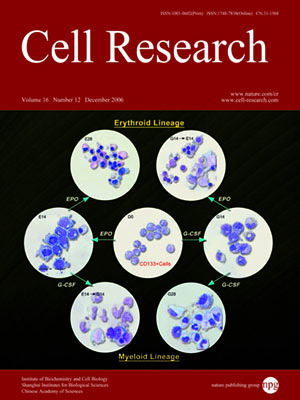
Volume 16, No 12, Dec 2006
ISSN: 1001-0602
EISSN: 1748-7838 2018
impact factor 17.848*
(Clarivate Analytics, 2019)
Volume 16 Issue 12, December 2006: 916-922
ORIGINAL ARTICLES
Heterotrimeric G protein α subunit is involved in rice brassinosteroid response
Lei Wang, Yun-Yuan Xu1, Qi-Bin Ma, Dan Li, Zhi-Hong Xu, Kang Chong
1Key Laboratory of Photosynthesis and Environmental Molecular Physiology, Institute of Botany, Chinese Academy of Sciences,Nanxincun 20, Xiangshan, Beijing 100093, China; 2Graduate School of the Chinese Academy of Sciences, 100046 Beijing, China;3National Plant Gene Research Center (Beijing), Beijing 100093, China
Correspondence: Kang Chong(chongk@ibcas.ac.cn)
Heterotrimeric G proteins are known to function as messengers in numerous signal transduction pathways. The null
mutation of RGA (rice heterotrimeric G protein α subunit), which encodes the α subunit of heterotrimeric G protein
in rice, causes severe dwarfism and reduced responsiveness to gibberellic acid in rice. However, less is known about
heterotrimeric G protein in brassinosteroid (BR) signaling, one of the well-understood phytohormone pathways. In the
present study, we used root elongation inhibition assay, lamina inclination assay and coleoptile elongation analysis to
demonstrated reduced sensitivity of
d1 mutant plants (caused by the null mutation of
RGA) to 24-epibrassinolide (24-
epiBL), which belongs to brassinosteroids and plays a wide variety of roles in plant growth and development. Moreover,
RGA transcript level was decreased in 24-epiBL-treated seedlings in a dose-dependent manner. Our results show that
RGA is involved in rice brassinosteroid response, which may be beneficial to elucidate the molecular mechanisms of G
protein signaling and provide a novel perspective to understand BR signaling in higher plants.
Cell Research (2006) 16:916-922. doi: 10.1038/sj.cr.7310111; published online 21 November 2006
FULL TEXT | PDF
Browse 1995


